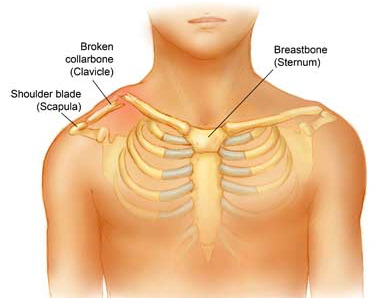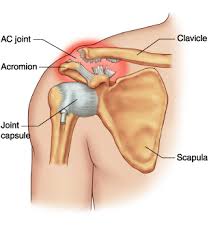The collarbone (clavicle) is the curved bone you feel between your neck and shoulder. This short bone above the ribs connects each upper arm to the body and supports the shoulder blade and the arm. It allows your arm to maximize its movements and helps to transmit any impact from your upper limb to the center of the body.
The collarbone lies close to your skin and is prone to injuries such as fractures and pain. Fractures of the clavicle are the most common injuries, resulting in pain, especially among football players, hockey players, and other athletes.
Causes and Treatment for Collarbone Pain
1. Collarbone Fractures
 Pain in collarbone due to fractures is often related to sports injuries that occur after falling on one’s shoulder, or falling on an outstretched hand to break the fall. Other causes include vehicle accidents and direct blow to the shoulder.
Pain in collarbone due to fractures is often related to sports injuries that occur after falling on one’s shoulder, or falling on an outstretched hand to break the fall. Other causes include vehicle accidents and direct blow to the shoulder.
The clavicle of a newborn baby may be fractured during a vaginal delivery. Collarbone injuries also occur in children and adolescents as the bone ossifies during their teenage years.
Symptoms:
Collarbone pain from a fracture can also cause extreme pain to your upper chest and shoulder whenever you move. You may be unable to move your arms. Forced movements can cause a clicking or popping sound. There is a bone deformity that is clearly seen as a lump on your shoulder along the fracture. Pain in collarbone is often accompanied by bruising, swelling, and tenderness, as well as dizzinessandnausea.
A broken clavicle may not be seen nor felt in newborn babies. However, your child may not be able to move the affected arm, or hold his arm against the side of the body. After a few days, the bone starts to heal and a bulge may be visible on the clavicle.
Treatment:
The fractured collarbone and the affected arm must first be immobilized and the shoulder supported with a "clavicle strap" or arm sling. The foam-padded clavicle strap must be used until the bone heals. This may take approximately 12 weeks to heal completely. Once removed, you will need physical therapy to restore strength to your shoulder.
To reduce inflammation and collarbone pain, apply ice packs on your shoulder. Surgery may be needed if the fractured bone fragments are severely displaced, or if the bones penetrate the skin.
2. Acromioclavicular Joint injuries
 Your shoulder consists of three bones that make up the acromioclavicular joint. These are the collarbone, the shoulder blade, and the end of the humerus or the large upper arm bone. This joint is stabilized by ligaments, which when torn or sprained, can cause collarbone pain. Injuries to this joint may be caused by a direct blow to the shoulder, a traumatic contact from the side, or overstress while lifting a heavy weight.
Your shoulder consists of three bones that make up the acromioclavicular joint. These are the collarbone, the shoulder blade, and the end of the humerus or the large upper arm bone. This joint is stabilized by ligaments, which when torn or sprained, can cause collarbone pain. Injuries to this joint may be caused by a direct blow to the shoulder, a traumatic contact from the side, or overstress while lifting a heavy weight.
Symptoms:
Acromioclavicular joint injuries can cause displacement of the clavicle and immediate swelling and pain. The pain is increased by activities that involve pulling, pushing, or reaching above your head.This causes restriction of the shoulder’s full range of motion.
Treatment:
Conservative treatment with an arm sling is recommended for minor injuries. With minor sprains, you can start physical therapy after a few weeks to restore joint strength. In severe injuries where clavicle dislocation occurs, surgical reconstruction can be done on the torn ligaments.
3. Osteoarthritis of the Acromioclavicular Joint
The acromioclavicular (shoulder) joint is subject to constant wear-and-tear, which results in degeneration of the cartilage that cushions the ends of the bones. Aside from normal aging, the most common cause of the arthritis of the shoulder is heavy weight lifting overhead. A previous injury can also lead to shoulder joint degeneration.
Symptoms:
Osteoarthritis triggers pain, inflammation, and tenderness in the shoulder, the chest and the neck. Collarbone pain may be mild but throbbing. Pain is worsened by activities that compress the joint such as crossing your arm across your chest.
Treatment:
Conservative treatment for osteoarthritis includes rest and use of anti-inflammatory medications. Cortisone injections may be prescribed for inflammation and extreme pain. Surgical treatment (resection arthroplasty) is reserved for severe cases. This involves removal of a small portion of collarbone to provide space between the clavicle and shoulder blade’s acromion. This reduces friction between bones and improves the movements of the joint.
4. Acute Osteomyelitis (Infection) of the Clavicle
Bone infection or osteomyelitis is often caused by bacteria. It may develop after an injury to the bone (acute osteomyelitis), or bacteria can be passed from a distant site through your bloodstream. It can occur after a head or neck surgery, but osteomyelitis involving the clavicle is quite rare.
Symptoms:
Common osteomyelitis symptoms include fever, extreme collarbone pain, and swelling over the clavicle. The affected area usually appears red and warm.
Treatment:
Treatment includes intravenous antibiotics for six to eight weeks. Surgery might be needed in severe cases.
5. Distal Clavicular Osteolysis
A fracture in the distal portion of the claviclecan cause clavicular osteolysis or weightlifter's shoulder. Lifting heavy weights and doing bench presses can cause constant stress on your shoulders and place excessive pressure on the shoulder joint, which can lead to collarbone pain.
Symptoms:
Shoulder pain can be felt when the shoulder joints are pressed. Pain may be worsened when you lie on your side while sleeping.
Treatment:
Rest and change in exercise routine can reduce the pain. If non-surgical measures do not improve your condition, your doctor may recommend distal clavicle resection.
6. Other Causes
Less common causes include sternoclavicular joint dislocation, clavicular arthritis, andbone tumor.
Complications of Collarbone Pain
If untreated, a fractured collarbone or ligament injury can lead to chronic pain. If the rough edges of the fractured bone irritate the skin, non-healing ulcers may develop over the bone, which can easily get infected.
